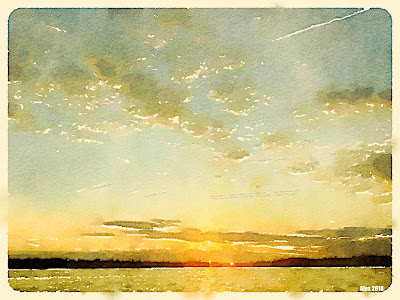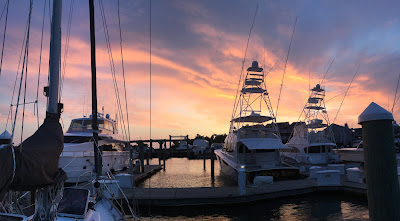At Little Neck Bay, where we were anchored, we were two hours away from Hells Gate. So, at 4:00 am we were up and got underway by 4:45 am. We were excited to traverse this great city by water and the illuminated skyline and bridge were a beautiful sight in early morning.
 |
| Throgs Neck Bridge, Little Neck Bay in Early Morning |
With RADAR, AIS and two chartplotters going, we raised anchor in some current. We knew we would have current against us initially and planned for that. New York is "The City that Never Sleeps" and even that early there was shipping traffic. We were soon passed by a 110 ft (34 m) power yacht and we spotted a tug pushing a barge a couple of miles behind us.
The approach to Hells Gate is narrow and full of sharp twists and turns. We kept our eyes open and monitored the approaching tug that was doing 8.5 knots (16 km/h). The currents at Hells Gate can run over 4 knots (7 km/h) and we had timed it to be there a couple of hours after slack water. The tug was closing in fast and with its limited maneuverability, we did not want to go through Hells Gate at the same time. So, we eased the throttle and slowed Rosalind to 2 knots (3.7 km/h) just to maintain steerage and let the tug pass us. The tug Captain waved and we tucked behind it and let its wake give us an extra boost. We went through Hells Gate at 9.4 knots (17 km/h)! The current pushing us was likely 2.5-3 knots (4.5-5.5 km/h) and we got almost 1.5 knots (2.5 km/h) additional pull from the tug so we were flying. By the time we reached Hells Gate it was daylight and we could see commuters driving to work. We left Roosevelt Island to port and we were passing through the heart of the city. There was the Chrysler Building and the Empire State Building and soon after that we passed in front of the United Nations. Cheryl was taking pictures while I was focused on keeping Rosalind pointing in the right direction in the strong current.
After Hells Gate marine traffic really picked up with ferries rushing in all directions. The slow ones were doing 21 knots (39 km/h) while the fast ones were doing 32 knots (59 km/h). We were surrounded. Even when doing 8 knots (15 km/h) we felt like we were standing still in a very busy intersection with everyone buzzing around us. We stayed to the side of the channel, all the Captains were very professional, and we did not have any trouble other than having to hold on as there were large wakes all over and we got tossed around some.
 |
| Chrysler and United Nation Buildings, New York City |
 |
| Empire State Building, New York City |
After Hells Gate marine traffic really picked up with ferries rushing in all directions. The slow ones were doing 21 knots (39 km/h) while the fast ones were doing 32 knots (59 km/h). We were surrounded. Even when doing 8 knots (15 km/h) we felt like we were standing still in a very busy intersection with everyone buzzing around us. We stayed to the side of the channel, all the Captains were very professional, and we did not have any trouble other than having to hold on as there were large wakes all over and we got tossed around some.
We passed under the Brooklyn Bridge, saluted the Statue of Liberty and crossed New York's Upper Bay where a handful of large ships were at anchor. Soon were passing under the Verrazzano-Narrows Bridge. Had it all been a dream?
We next turned to starboard and soon were navigating the narrow and shallow channel into Great Kills. We motored through the mooring field, past a sunken sailboat with only the tip of its mast sticking out above the water, and dropped anchor. We were near the Great Kills Park that had a dinghy landing, the only convenient place to get to shore. In the afternoon we went to shore and met with our friend Lydia, who works in the area, and then returned onboard just after sunset.
The dinghy landing area at Great Kills, unfortunately, was not the best. Without any other options for getting to shore, we decided to move on to another port. So, the next day we were off to Atlantic Highlands, New Jersey.
















































